
All Maui travel guides feature the most gorgeous beach setting with blue skies, warm sunshine, and swaying palms. And the Maui weather delivers on that dreamy ideal, at least in most regions and for most of the year. But when is the rainy season in Maui? And is it something to consider when planning your trip to the island?
Maui is a tropical destination so, yes, rainfall does occur on the island. Then again, the weather in Maui is very different from the mainland. So much so, that there’s really no need to avoid the rainy season in Maui. On the contrary, it even coincides with some incredible seasonal activities such as whale-watching.
That being noted, it’s crucial to carefully select your Maui accommodations to minimize your chance of rain. You’ll want to avoid those Maui vacation rentals and hotels that are situated in the wetter regions.
Are you ready to find out how to make the most of your vacation during the rainy season? Then let’s dive in!
In a nutshell
This article explains the Maui weather in an easy-to-understand way, zooms in on the rainfall by region, highlights the pros and cons of the rainy season in Maui and features some practical travel tips to enjoy Maui regardless of the occasional shower.
Affiliate links are sprinkled throughout the site content. Clicking on such a hyperlink and making a booking on the accommodation platform it refers to may result in a commission for PlacesToStayMaui.com at no additional cost to you. For more information, visit the Disclaimer page.
Rainy season activities to book ahead of time
The following seasonal tours tend to sell out quickly so be sure to secure your reservation.
Maui weather explained
The weather in Maui Hawaii is a result of a dynamic interplay between mountains and wind.
The most prominent topographic landmarks in Maui are the Haleakala and the West Maui mountains. These act as a natural barrier against winds. The winds that are most prevalent in Maui are the trade winds that blow consistently from the northeast.
The windswept northeastern coasts are known as the windward side of the island while the shielded southwestern coasts are the leeward sides.
As these northeast winds travel over the water, they pick up moisture. When they hit the mountain slopes, they are forced to ascend but only up to a certain point where they stay locked. This causes cooling and condensation which, in turn, generates clouds and precipitation.
Because the trade winds don’t reach over the mountains, the wettest place on Maui can’t be found on the top of the Haleakala but rather at lower peaks like Big Bog on the slopes of the Haleakala and Pu’u Kukui in the West Maui mountains. When you visit the top of Haleakala National Park, you can see the weather unfold.
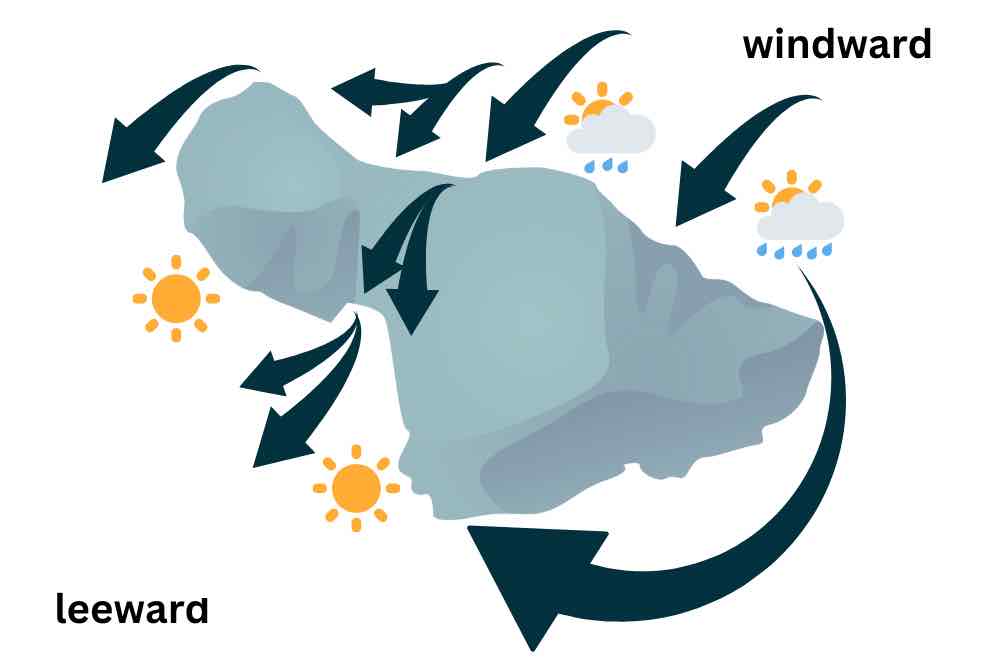
The rain stays in place on the windward side but the wind doesn’t. It wraps around and funnels between the mountains, bringing cool breezes to the southwestern coast. These moderate the humidity.
This unique interaction between the mountains and winds creates various microclimates or small-scale weather patterns on the compact island. The regions of South Maui and West Maui have the driest, sunniest weather with a pleasant breeze. However, the towns of Kapalua, Napili, Maalaea, and Makena will always be somewhat windier due to their position at the edge of the mountains where the trade winds pass by.
The Maui climate is pretty predictable because of the consistency of the trade winds. Most of the rainfall occurs on the windward coasts in the late afternoon and overnight. The mornings tend to be less rainy.
Maui weather by season
Maui only has two seasons: a summer season (May to October) and a winter season (November to April).
In terms of temperature, the extremes are still pretty subtle with daytime averages between 75° F and 85° F.
Maui regions on higher grounds, such as Upcountry Maui, tend to be cooler. Maui regions near the windward coasts tend to be more humid. South and West Maui tend to be mostly sunny and thanks to the light breeze, the temperatures are nice and comfortable, and an occasional drizzle comes and goes.
Then again, as mentioned before, Maui boasts several microclimates. These don’t affect the temperature as much as they affect the precipitation.
Here’s an overview of the average rainfall in Maui by region to help you visualize.
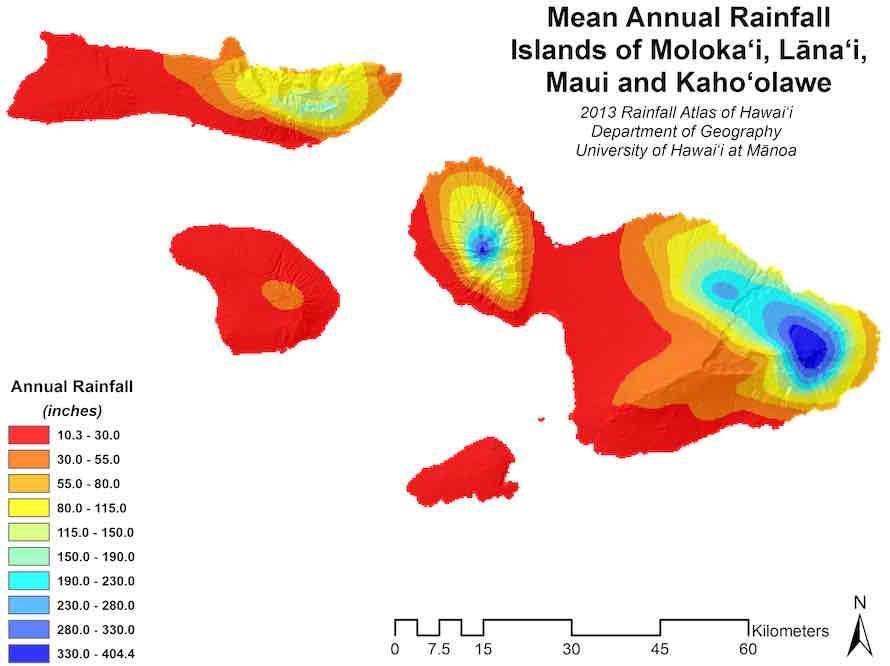
© Giambelluca, T.W., Q. Chen, A.G. Frazier, J.P. Price, Y.-L. Chen, P.-S. Chu, J.K. Eischeid, and D.M. Delparte, 2013: Online Rainfall Atlas of Hawai‘i. Bull. Amer. Meteor. Soc. 94, 313-316, doi: 10.1175/BAMS-D-11-00228.1
When is the rainy season in Maui Hawaii?
The rainy season in Maui coincides with the peak winter months. The wettest months in Maui are November to March.
It’s when the trade winds are less prevalent and more variable winds and rainfall occur because of winter-related cold fronts in the Northern Hemisphere. Instead of isolated showers on the northeastern coast, there are more scattered showers over the island.
The comparison of Maui rainfall by month during the driest summer month (July) and the wettest summer month (January) shows more scattered showers during the rainy season in Maui.
The rain usually only lasts for a couple of hours. So, even on the wetter days, the sun usually shines.
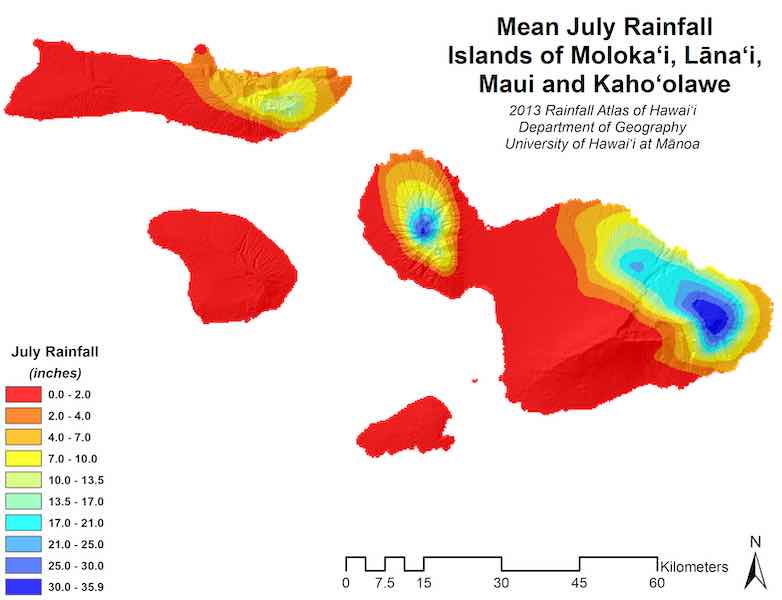
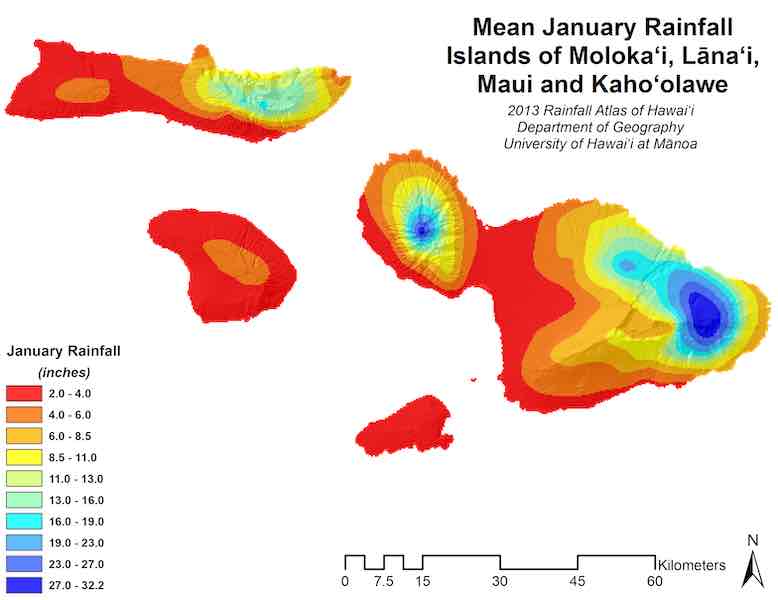
© Giambelluca, T.W., Q. Chen, A.G. Frazier, J.P. Price, Y.-L. Chen, P.-S. Chu, J.K. Eischeid, and D.M. Delparte, 2013: Online Rainfall Atlas of Hawai‘i. Bull. Amer. Meteor. Soc. 94, 313-316, doi: 10.1175/BAMS-D-11-00228.1
September and October are known as the hurricane season in the Central Pacific. Luckily, the majority of storms take place far away from Maui.
But when the occasional storm does occur, it’s likely to do so during the rainy season. And, unfortunately for tourists, the heaviest storms happen to hit the leeward coastlines more than the windward coasts.
There’s no way to predict if a storm will occur at the time of setting your travel plans. But even if you happen to visit Maui during a storm, then there’s no need to panic. Most of the time, there’ll be another region in Maui that’s not impacted by the storm. So, just hop in your rental car and head to a sunny part of the island.
Where to stay in Maui during the rainy season?
Now that you have some insight into Maui’s rainy season, it’s time to pinpoint the best places to stay to minimize your chance of rain.
Best Maui weather forecast
Due to the microclimates, no one forecast for Maui can capture the weather on the entire island. The standard Kahului weather forecast won’t do you much good if you’re not staying in Kahului. Instead, you’ll have to look at a forecast per region.
Here are my top picks for weather reports.
When visiting Maui, you’ll most likely be planning day trips to various regions of the island. Be sure to always check the weather at your destination to avoid unpleasant surprises.
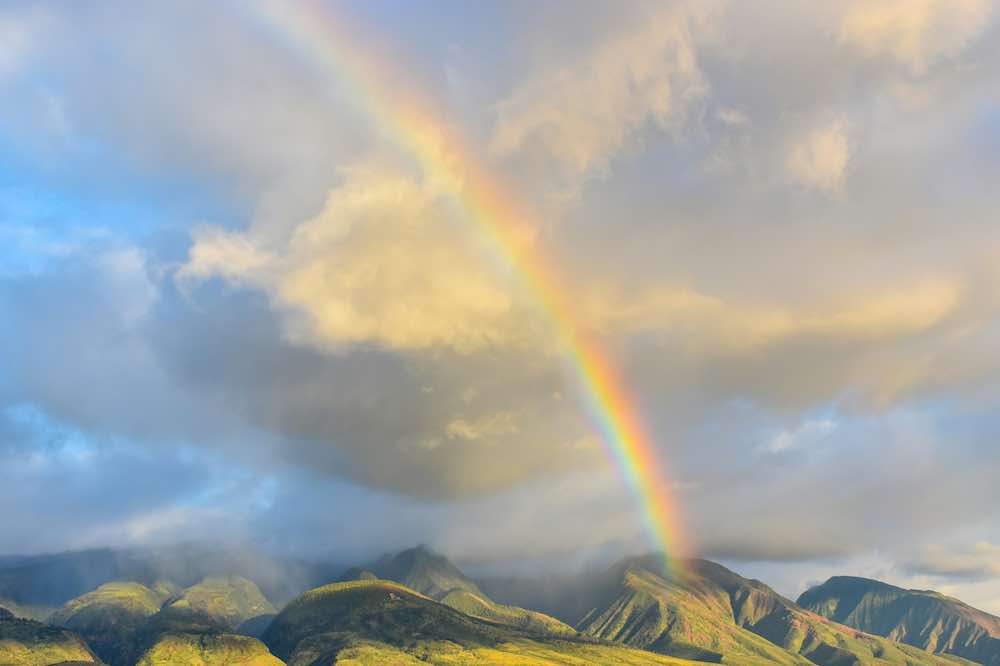
Best time to go to Maui weather-wise
As far as the weather goes, there’s no bad time to visit Maui. Yes, there’s a rainy season but it’s relative in comparison to the wintery weather at most other places in the Northern Hemisphere. If you’re looking to escape the cold, then Maui is a solid choice any time of the year.
The best proof that the rainy season in Maui is no object, is that it coincides with the high season. That’s because the best time to visit Maui depends on more than just the weather, school holidays for one. The worst time to go to Maui is basically during Christmas and New Year. But that has everything to do with skyrocketing prices and nothing with the weather on Maui.
Here’s an overview of the pros and cons when visiting Maui during the rainy season.
Pros of the rainy season in Maui
The rainy weather in Maui brings so much beauty to the island. Here are some reasons why you should consider visiting Maui during the rainy season.
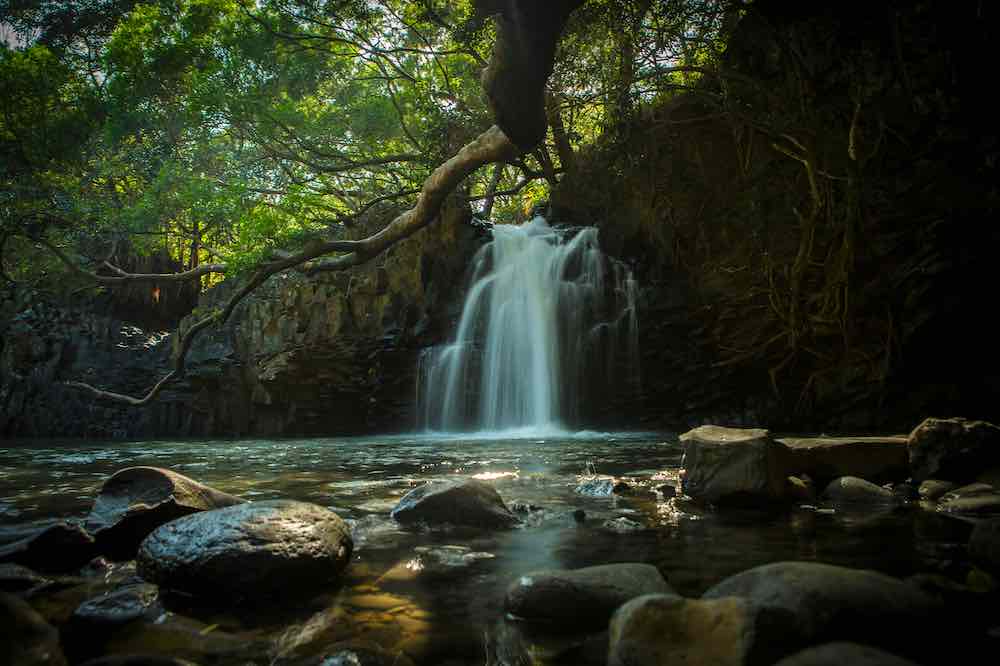
Cons of the rainy season in Maui
Of course, it’s not all sunshine and rainbows. The rain can be a dealbreaker too. Here are some reasons that could keep you from visiting Maui during the rainy seasons.
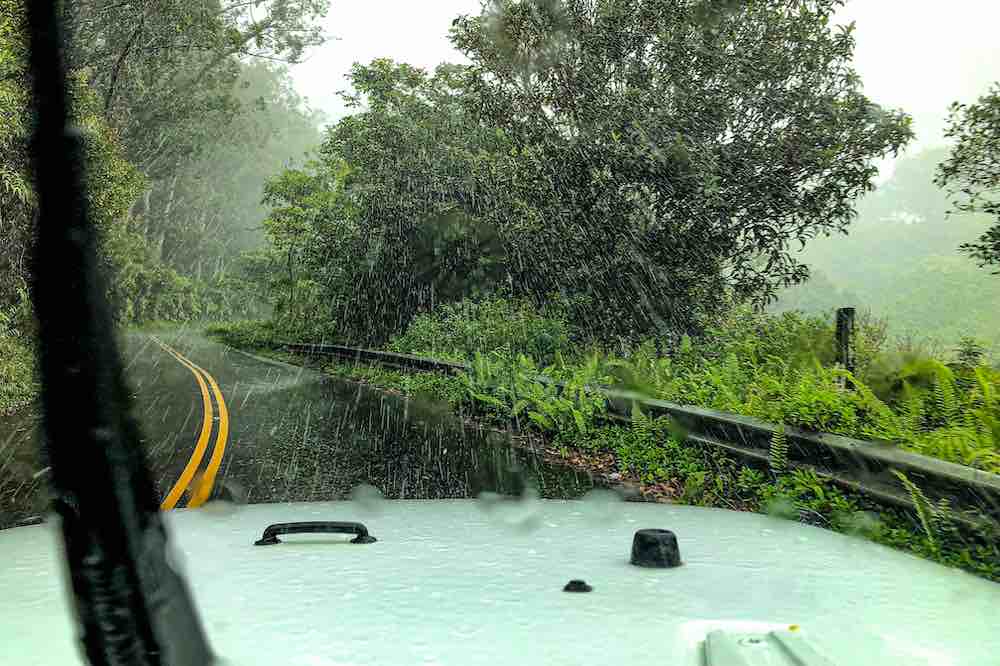
Travel tips for the rainy season in Maui
If you do decide to travel to Maui no matter the weather, then here are some things that you could do to enjoy the island’s beauty regardless of the rain.







